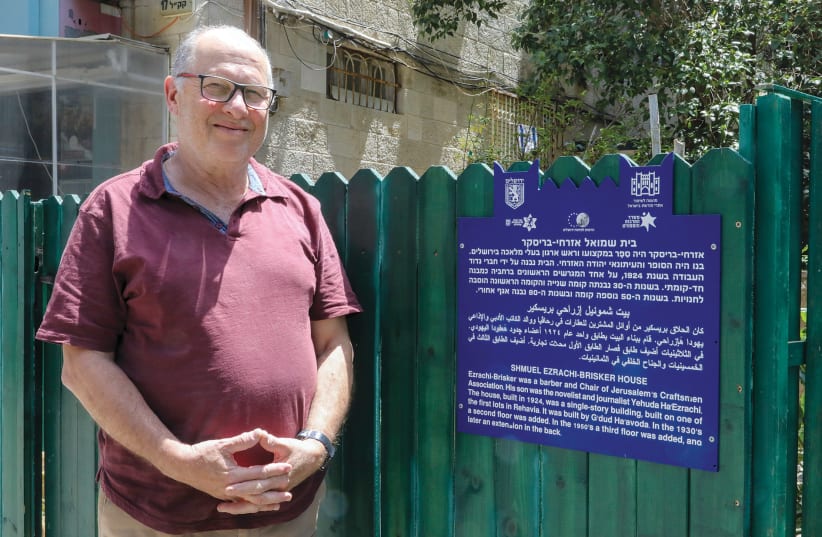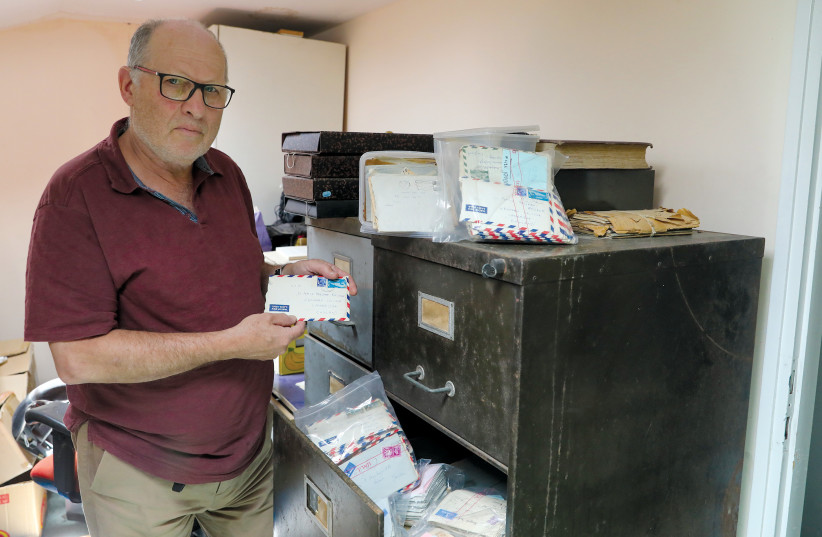Elan Ezrachi was barely eight-years-old when his uncle, already a famous writer and activist against unregulated high-rise construction in the city, rushed into the family home early one morning to announce the death of his wife, Pepita Haezrachi, a remarkable philosopher who taught at the philosophy department of the Hebrew University of Jerusalem.
In the late 1950s and early 1960s, they were the most prominent intellectual and romantic couple in Jerusalem. Almost 60 years later, Dr. Elan Ezrachi, a lecturer on American Jews, found thousands of letters exchanged over the years between Yehuda and his beloved Pepita in the attic of the family’s house in Rehavia.
Elan, who has published a book on the life of modern Jerusalem from his point of view as a Sabra, is a second generation born in the city. He wrote the story of his uncle and Pepita, and talks about the Jerusalem of our days, describing it as the most fascinating pluralistic city in the country, and claims that most of the damage to its image is actually caused by Jerusalemites who are unable to discern its uniqueness.
“It was the little Jerusalem before the reunification of 1967,” recalls Elan, and my uncle, Yehuda Ezrachi (who changed his surname to Haezrachi), was the first child born in Rehavia, which will soon celebrate its 100th anniversary. The Brixer family, who became Ezrachi, were Elan’s grandparents, who immigrated at the beginning of the last century in the second aliyah. They chose to settle in Jerusalem and built their home on Keren Kayemet Street. Elan and his family still live in the same building, which has a sign in front of the building documenting the building’s affiliation.
“I knew the story of Yehuda and Pepita, but I never delved into it,” Elan recalls, “until that day, when I happened to come across a heavy iron cabinet that had been kept in the basement of our house since Yehuda’s death. Out of curiosity, I opened it and found a treasure – thousands of letters exchanged between Yehuda and Pepita. I immersed myself in reading the letters and was first exposed to an extraordinary love story, as well as the hardships and great sorrow that were Pepita’s part and ended so tragically one morning in Jerusalem in the early Sixties.”
However, the in-depth study of the letters gave birth to a book that describes not only the experiences of Yehudah and Pepita, but also the background to this period in Jerusalem.
The eve of the launch of the book took place at the Ginot Ha’ir Community Center, which Elan was its chairman until recently. Prof. Meir Bouzaglo, from the Department of Philosophy at the Hebrew University, praised the work of Pepita and her impressive thought with great emotion. Buzaglo emphasized both her original and ground-breaking thoughts, as revealed in her books, and pointed to the fact that in those years, being so brilliant and innovative but also the only woman in the faculty was at the root of the great difficulties she encountered throughout her short life. It probably led her to the tragic decision to commit suicide, at age 46.
The book K’av Tehumi v’Oneg Ila’i (Abysmal Pain and Supreme Pleasure) is much more than the story of a loving couple against the backdrop of cityscapes. As someone who was for many years – and still is today – involved in working for Jerusalem and its inhabitants, Elan sketches for us as he already did, through his previous book Sane in Her Dream – highs and lows in the 50th anniversary of the unification of Jerusalem, the uniqueness and characterization of the city where he was born and raised and shatters the negative image that clung to it.
“My father was born on the day the opening ceremony of the Hebrew University took place on Mount Scopus, April 1 1925,” continues Elan. “In fact, this is the environment in which I too was born and raised – the university, the national institutions here, on the corner of King George and our street, Keren Kayemet. I am a third generation Israeli and in the city, still living in the building my grandparents built 78 years ago. These days, as we are approaching Independence Day, I want to talk about Jerusalem in the perspective of the Zionist enterprise as I understand it through my researches and knowledge.”
Discovering the uniqueness of Jerusalem
Trying to establish the roots of the ambivalent attitude toward the capital, Elan says that the Zionist movement has been ambivalent toward Jerusalem since its inception. “Jerusalem is of course in the symbolic and traditional sense the source of everything – the word Zionism is the root of the word Zionism and also the name of Jerusalem – but when the Zionist project was launched and began to materialize with the arrival of waves of new immigrants, Jerusalem did not fit the highest priority. On the priority list of the goals of the Zionist movement were the agricultural settlements and the establishment of Tel Aviv, the first Hebrew city.
“The British made the city a gem and without them, Jerusalem would have remained a poor Turkish village. In fact, they put Jerusalem at the center much more than the members of the Zionist movement intended.”
Yet, the Zionist leadership of those days realized already in the 1920s that it was impossible for the Zionist project not to see Jerusalem as an important focus. Therefore, the political center – the national institutions were moved here. “But the Zionist movement still had to solve this dilemma toward Jerusalem, as they felt disgust toward it, and at the same time realized that it is impossible without it,” continues Elan.
“The solution to this dilemma was to establish a Western city inside Jerusalem, to break the image perceived until then as a city that is mainly the Old City, and establish a new city west of this ancient city and called it also Jerusalem. This new Jerusalem turned its back on the Old City, faced to the west, and its development from the last century up to 1967 was toward the west. The narrative was that Jerusalem is important, but without the religious and the Arab side, but then came the Six Day War and this whole approach was crushed.”
Since 1967, the narrative talks about the united city. From that moment, the narrative became more national and religious, and the talk about Jerusalem to the west was no longer present. Until then, the Western symbols of Jerusalem were the university, Mount Herzl, the Government Campus, and the Israel Museum – all symbols of the new republic of Israel.
Recalling his youth in the city that suddenly tripled in size and radically changed it’s character, Elan says that before he wanted to be active, involved and document the city, he realized that he himself was a product of this Western city. “In the messages my brother and I received at home, Jerusalem was important, but not in the religious context. We were a traditional family but our life here was an Ashkenazi secular life. We went to the gymnasium, the scout movement, and we didn’t have a nightlife or anything special on the weekend – and make no mistake, even in Tel Aviv in those years nothing was open on Shabbat, just like here.”
“The years immediately following the Six Day War were really fun years in Jerusalem. We discovered all the new places we didn’t know and from my point of view, it was like I got a new city without leaving Jerusalem,” he said. “My uncle, Yehuda, became a tour guide and on Saturday mornings we would go for a walk in the Old City, everything was accessible, there was no security threat. In those days, the Arabs were defeated and we were thrilled by the abundance and Westerness of Israel to which we were suddenly exposed. We could go anywhere.”
Pluralism and creative activism
For the past 20 years, Elan has been deeply involved in several aspects of civil society activism in the city. As initiator and founder of Yeru-Shalem, a non-profit dedicated to deepen and strengthen the ties between pluralists Jerusalemites and North American Jews, for some 20 years the chairman of the Ginot Hair local council and in parallel, a lecturer on Israel and American Jews relationships for the University of Haifa.
“In the 1980s, after absorbing Judah’s great involvement for Jerusalem, I began to develop my special relationship with my hometown. So I developed a feeling that non-Jerusalemites do not understand us. I am an air force man and when I come to the squadron club in Tel Aviv once a week, there is always a pilot who asks me ‘Ezrachi, are you still in Jerusalem?’ And this question makes me ask myself why do I actually live in this city? And from this, I began to develop the intuition that this city has some quality that does not exist anywhere else in the country,” he says.
He continues, “From there came my growing interest in Jerusalem with the establishment of the Tali elementary school, the involvement in the Kol Haneshama community (of the Reform Movement) demonstrations led by the late Ornan Yekutieli (a classmate) for the opening of cinemas on Shabbat. There was high social and political activity in the city, but every time I am out of Jerusalem, there is no mention of these things because in Tel Aviv they only deal with how to make money or where to drink coffee, and they looked at Jerusalem as a place where there are only ultra-Orthodox and Arabs. This space we created here, the pluralistic, creative activism, did not exist in their mind.”
In 2000, Elan joined the Ginot Hair local council, which, together with its CEO, Shaike El-Ami, created the pluralistic space of Jerusalem – with Jewish renewal, sharing with different groups in the population, Kabbalat Shabbat and civic involvement – we actually created our Jerusalem within Jerusalem, in Rehavia, the German Colony, Baka, Katamon and more.
In conclusion, he says, “In our protests and activism, we did not agree to a haredi request to force a dance studio in the city center to hide the dancers, but on the other hand, we did not broadcast hatred of the ultra-Orthodox or hatred of religion. Today, I concentrate on what my family did in this city, on the conceptualization of what happened here after 1967, and my activities in this space, whose essence is to continue to cultivate this notion that our Jerusalem is a modern, liberal, pluralistic Western city with an amazing Jewish renewal lab.” ❖

